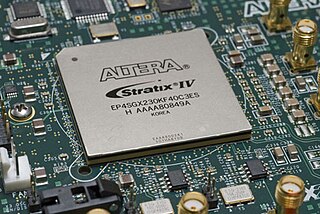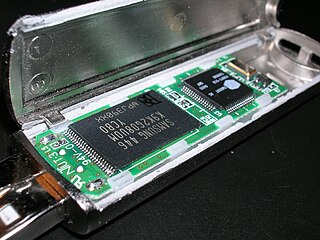
A field-programmable gate array (FPGA) is a type of integrated circuit that can be programmed or reprogrammed after manufacturing. It consists of an array of programmable logic blocks and interconnects that can be configured to perform various digital functions. FPGAs are commonly used in applications where flexibility, speed, and parallel processing capabilities are required, such as in telecommunications, automotive, aerospace, and industrial sectors.

Intel Corporation is an American multinational corporation and technology company headquartered in Santa Clara, California. It is one of the world's largest semiconductor chip manufacturers by revenue. Intel supplies microprocessors for most manufacturers of computer systems, and is one of the developers of the x86 series of instruction sets found in most personal computers (PCs). Intel also manufactures chipsets, network interface controllers, flash memory, graphics processing units (GPUs), field-programmable gate arrays (FPGAs), and other devices related to communications and computing.

Flash memory is an electronic non-volatile computer memory storage medium that can be electrically erased and reprogrammed. The two main types of flash memory, NOR flash and NAND flash, are named for the NOR and NAND logic gates. Both use the same cell design, consisting of floating gate MOSFETs. They differ at the circuit level depending on whether the state of the bit line or word lines is pulled high or low: in NAND flash, the relationship between the bit line and the word lines resembles a NAND gate; in NOR flash, it resembles a NOR gate.
Atmel Corporation was a creator and manufacturer of semiconductors before being subsumed by Microchip Technology in 2016. Atmel was founded in 1984. The company focused on embedded systems built around microcontrollers. Its products included microcontrollers radio-frequency (RF) devices including Wi-Fi, EEPROM, and flash memory devices, symmetric and asymmetric security chips, touch sensors and controllers, and application-specific products. Atmel supplies its devices as standard products, application-specific integrated circuits (ASICs), or application-specific standard product (ASSPs) depending on the requirements of its customers.

STMicroelectronics N.V. is a multinational corporation and technology company of French-Italian origin. It is headquartered in Plan-les-Ouates and listed on the New York Stock Exchange, on the Euronext Paris in Paris and on the Borsa Italiana in Milan. ST is the largest European semiconductor contract manufacturing and design company. The company resulted from the merger of two government-owned semiconductor companies in 1987: Thomson Semiconducteurs of France and SGS Microelettronica of Italy.
Renesas Electronics Corporation is a Japanese semiconductor manufacturer headquartered in Tokyo, Japan, initially incorporated in 2002 as Renesas Technology, the consolidated entity of the semiconductor units of Hitachi and Mitsubishi excluding their dynamic random-access memory (DRAM) businesses, to which NEC Electronics merged in 2010, resulting in a minor change in the corporate name and logo to as it is now.

Micron Technology, Inc. is an American producer of computer memory and computer data storage including dynamic random-access memory, flash memory, and USB flash drives. It is headquartered in Boise, Idaho. Its consumer products, including the Ballistix line of memory modules, are marketed under the Crucial brand. Micron and Intel together created IM Flash Technologies, which produced NAND flash memory. It owned Lexar between 2006 and 2017.

Cypress Semiconductor was an American semiconductor design and manufacturing company. It offered NOR flash memories, F-RAM and SRAM Traveo microcontrollers, PSoC programmable system-on-chip solutions, analog and PMIC Power Management ICs, CapSense capacitive touch-sensing controllers, Wireless BLE Bluetooth Low-Energy and USB connectivity solutions.

Altera Corporation was a manufacturer of programmable logic devices (PLDs) headquartered in San Jose, California. It was founded in 1983 and acquired by Intel in 2015.
Phase-change memory is a type of non-volatile random-access memory. PRAMs exploit the unique behaviour of chalcogenide glass. In PCM, heat produced by the passage of an electric current through a heating element generally made of titanium nitride is used to either quickly heat and quench the glass, making it amorphous, or to hold it in its crystallization temperature range for some time, thereby switching it to a crystalline state. PCM also has the ability to achieve a number of distinct intermediary states, thereby having the ability to hold multiple bits in a single cell, but the difficulties in programming cells in this way has prevented these capabilities from being implemented in other technologies with the same capability.

SK hynix Inc. is a South Korean supplier of dynamic random-access memory (DRAM) chips and flash memory chips. Hynix is the world's second-largest memory chipmaker and the world's sixth-largest semiconductor company. Founded as Hyundai Electronic Industrial Co., Ltd. in 1983 and known as Hyundai Electronics, the company has manufacturing sites in Korea, the United States, mainland China and Taiwan. In 2012, when SK Telecom became its major shareholder, Hynix merged with SK Group.
Actel Corporation was an American manufacturer of nonvolatile, low-power field-programmable gate arrays (FPGAs), mixed-signal FPGAs, and programmable logic solutions. It had its headquarters in Mountain View, California, with offices worldwide. In November 2010, Microsemi acquired Actel for $430 million.
The 22 nm node is the process step following 32 nm in CMOS MOSFET semiconductor device fabrication. The typical half-pitch for a memory cell using the process is around 22 nm. It was first demonstrated by semiconductor companies for use in RAM memory in 2008. In 2010, Toshiba began shipping 24 nm flash memory chips, and Samsung Electronics began mass-producing 20 nm flash memory chips. The first consumer-level CPU deliveries using a 22 nm process started in April 2012 with the Intel Ivy Bridge processors.

IM Flash Technologies, LLC was the semiconductor company founded in January 2006, by Intel Corporation and Micron Technology, Inc. IM Flash produced 3D XPoint used in data centers and high end computers. It had a 300mm wafer fab in Lehi, Utah, United States.

In electronics, a multi-level cell (MLC) is a memory cell capable of storing more than a single bit of information, compared to a single-level cell (SLC), which can store only one bit per memory cell. A memory cell typically consists of a single floating-gate MOSFET, thus multi-level cells reduce the number of MOSFETs required to store the same amount of data as single-level cells.

Spansion Inc. was an American-based company that designed, developed, and manufactured flash memory, microcontrollers, mixed-signal and analog products, and system-on-chip (SoC) solutions. The company had more than 3,700 employees in 2014 and was headquartered in Sunnyvale, California. Spansion was a joint-venture between AMD and Fujitsu.
GigaDevice Semiconductor is a Chinese NOR flash memory designer. It also produces microcontrollers, some of them are based on the ARM architecture, and other on the RISC-V architecture. GD32 chips were introduced in 2015 and are compatible in pinout and periphery options to the STM32 line of microcontrollers.










